Home / Nucleophilic Aromatic Substitution (NAS)
Reactions of Aromatic Molecules
Nucleophilic Aromatic Substitution (NAS)
Last updated: February 16th, 2025 |
Nucleophilic Aromatic Substitution (NAS)
In many ways, nucleophilic aromatic substitution is the mirror opposite of electrophilic aromatic substitution.
- In Nucleophilic Aromatic Substitution, an electron-poor aromatic ring is attacked by a nucleophile, resulting in a substitution reaction
- The reaction proceeds through a negatively charged (carbanion) intermediate
- The reaction is accelerated by the presence of electron-withdrawing groups on the aromatic ring
- The placement of electron withdrawing groups ortho- or para- to the leaving group results in faster reactions than does the placement of electron withdrawing groups meta- to the leaving group
- Fluorine can act as a leaving group (!) in nucleophilic aromatic substitution reactions, since it is quite electron-withdrawing and C-F bond breakage is not the rate-limiting step.

Table of Contents
- Probably Not The Aromatic Substitution Reaction You Were Expecting
- Introducing….Nucleophilic Aromatic Substitution
- The Effect Of Substituents On The Ring
- The Effect Of The Leaving Group
- The Effect Of Substitution Pattern
- The “Meisenheimer” Intermediate Provides A Clue To The Mechanism of Nucleophilic Aromatic Substitution
- The Mechanism of Nucleophilic Aromatic Substitution
- Why Is The para- Isomer Faster Than The meta- Isomer ? It’s All About Stabilizing Negative Charge
- The Reaction Energy Diagram Of SNAr
- A Few Examples
- Summary: Nucleophilic Aromatic Substitution
- Notes
- Quiz Yourself!
- (Advanced) References and Further Reading
1. Probably Not The Aromatic Substitution Reaction You Were Expecting
Let’s review electrophilic aromatic substitution (EAS). What have we learned?
- The aromatic ring acts as a nucleophile, and attacks an added electrophile E
- An electron-deficient carbocation intermediate is formed (the rate-determining step) which is then deprotonated to restore aromaticity
- electron-donating groups on the aromatic ring (such as OH, OCH3, and alkyl) make the reaction faster, since they help to stabilize the electron-poor carbocation intermediate
- Lewis acids can make electrophiles even more electron-poor (reactive), increasing the reaction rate. For example FeBr3 / Br2 allows bromination to occur at a useful rate on benzene, whereas Br2 by itself is slow).
Everything we’ve learned so far about substitution on aromatic rings would teach us that it proceeds much faster with methoxybenzene than with nitrobenzene, and much faster with an electrophile like Cl2 than with, say, an electron-rich nucleophile like NaOCH3.
Which brings us to the reaction below. The aromatic ring is electron-poor and we’re adding an electron-rich nucleophile.
What could happen here? Nothing, right?
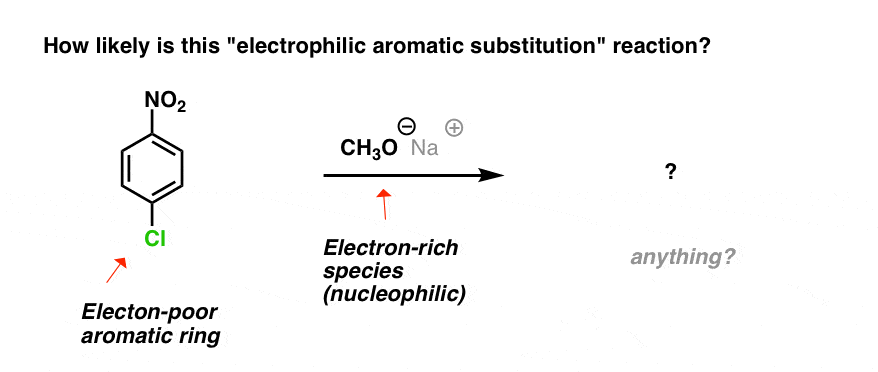
“Nothing” is a good guess! Certainly, thinking of this as an electrophilic aromatic substitution, you’d be right in thinking that the answer to “what happens here?” is “jack squat”.
2. Introducing….Nucleophilic Aromatic Substitution
In fact, a substitution reaction does occur! (But, as you may suspect, this isn’t an electrophilic aromatic substitution reaction.)
In this substitution reaction the C-Cl bond breaks, and a C-O bond forms on the same carbon.
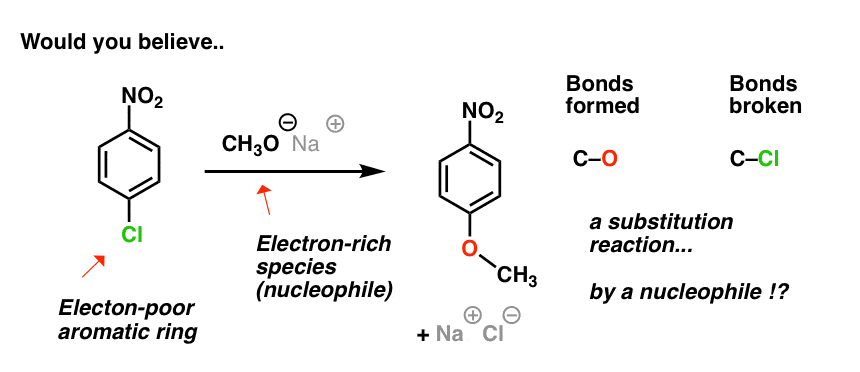
So while it is a substitution reaction, it has a few important differences:
- The species that attacks the ring is a nucleophile, not an electrophile
- The aromatic ring is electron-poor (electrophilic), not electron rich (nucleophilic)
- The “leaving group” is chlorine, not H+
- The position where the nucleophile attacks is determined by where the leaving group is, not by electronic and steric factors (i.e. no mix of ortho– and para- products as with electrophilic aromatic substitution).
In short, the roles of the aromatic ring and attacking species are reversed!
The attacking species (CH3O–) is the nucleophile, and the ring is the electrophile.
Since the nucleophile is the attacking species, this type of reaction has come to be known as nucleophilic aromatic substitution.
3. The Effect Of Substituents On The Ring
In nucleophilic aromatic substitution (NAS), all the trends you learned in electrophilic aromatic substitution operate, but in reverse.
The first trend to understand is that electron withdrawing groups (EWG’s) dramatically increase the rate of reaction, not decrease it.
From this, it follows that the more EWG’s there are, the faster the reaction.
For example, the rate of NAS for 2,4-dinitrophenyl chloride is about 105 times faster than for p-nitrophenyl chloride. [Note 1]
(I don’t have a rate constant for 2,4,6-trinitrophenyl chloride readily available, but it is orders of magnitude faster still).

4. The Effect Of The Leaving Group
One of the most eye-opening aspects of nucleophilic aromatic substitution is noting that fluorine is often used as a leaving group. This is seen in Sanger’s reagent for sequencing peptides, to take one example (more on that below).
After all, given the stern tones we instructors use in Org 1 on this subject, the words “FLUORINE IS NEVER A LEAVING GROUP IN SN2 AND SN1 REACTIONS” may as well have been carved on one of the stone tablets handed down to Moses on Mt. Sinai.
Here’s a thought: if even a “bad” leaving group like fluorine works in nucleophilic aromatic substitution, then surely a “better” leaving group like bromine or iodine would work even better. Right?
This is a good hunch. It is also wrong – which does not make it a dumb idea, only that organic chemistry is deep.
For one reaction studied [Note 3], F as the leaving group was observed to be 3300 times faster than iodine !
And between chlorine, bromine, and iodine, the difference was only by a factor of about 3.
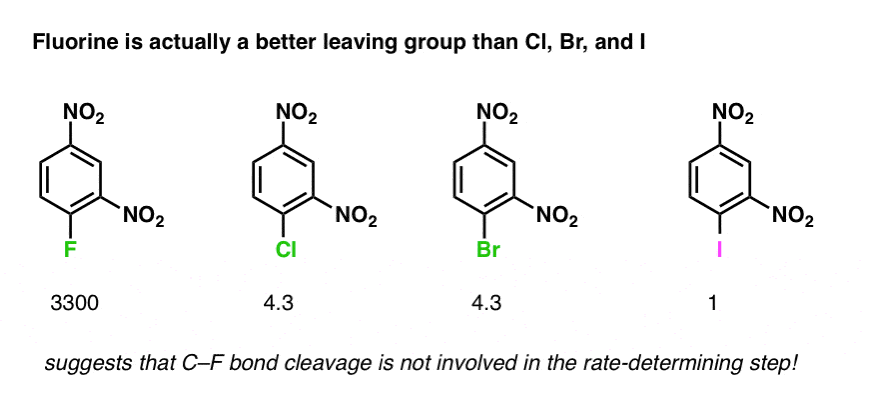
So what could be different about nucleophilic aromatic substitution that makes the rate of reaction much less sensitive to the identity of the leaving group than the SN1 and SN2 reactions?
Well, for one thing, this would suggest that, unlike the SN1 and SN2 reactions, C-F bond cleavage does not occur in the rate-determining step. This information is helpful in coming up with a mechanism for the reaction.
5. The Effect Of Substitution Pattern
Unlike in electrophilic aromatic substitution, there are no “ortho-,para-” or “meta-” directors. The position of substitution is controlled by the placement of the leaving group.
However that isn’t to say that the rate of the reaction isn’t affected by the relative position of the leaving group and the electron-withdrawing group.
For example, nucleophilic aromatic substitution of p-nitrophenyl fluoride is orders of magnitude faster than m-nitrophenyl fluoride, even though the NO2 is closer to the leaving group and should presumably exert more of an inductive effect.
The ortho isomer is also faster than the meta by a large margin.

What’s going on?
6. The “Meisenheimer” Intermediate Provides A Clue To The Mechanism of Nucleophilic Aromatic Substitution
In the course of adding nucleophiles to various electron-poor aromatic molecules with a leaving group, intermediates have been isolated. One of the first was isolated in 1902 by Jacob Meisenheimer, and the general name “Meisenheimer complex” is given to these intermediates.
The intermediate is the (non-aromatic) addition product between the aromatic ring and the nucleophile. In the case below, the negative charge is delocalized to an oxygen on one of the nitro groups:

Meisenheimer intermediates can be isolated and characterized. However, if heated, the compound goes on to form the final nucleophilic aromatic substitution product.
This is very suggestive, to say the least.
7. The Mechanism of Nucleophilic Aromatic Substitution
Taking all of these observations into account we can now propose a mechanism for this reaction.
The first step is attack of the nucleophile on the electron-poor ring to generate a negatively charged intermediate (e.g. the “Meisenheimer” intermediate, above)
Since this disrupts the aromaticity of the ring, it’s also the rate-limiting step:
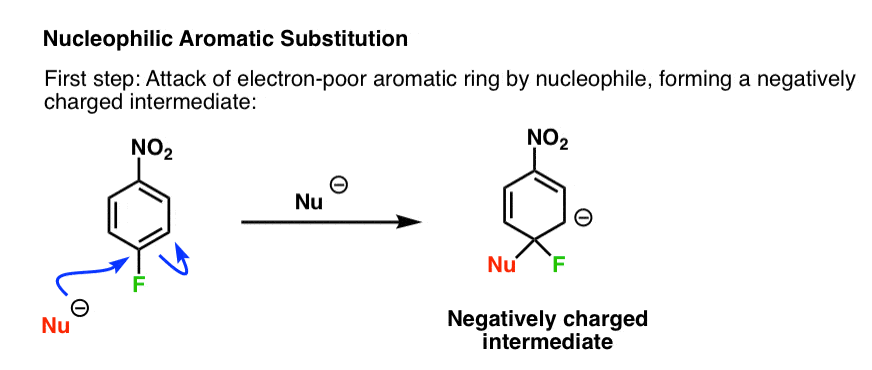
In electrophilic aromatic substitution (EAS) we saw that electron-rich substituents stabilized the electron-poor intermediate.
But in nucleophilic aromatic substitution (NAS) the tables are turned! Instead, the intermediate is electron-rich, and is stabilized by electron-withdrawing substituents, such as NO2.
The second step in nucleophilic aromatic substitution is expulsion of the leaving group:
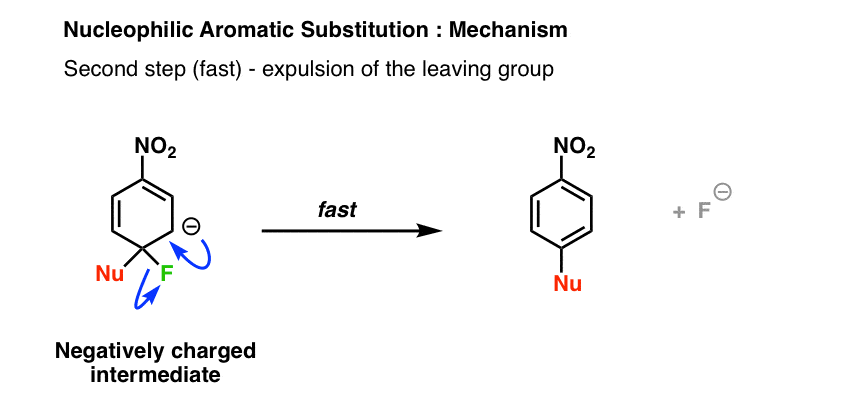
8. Why Is The para- Isomer Faster Than The meta- Isomer ? It’s All About Stabilizing Negative Charge
This two-step mechanism where addition is the rate-determining step helps to explain our earlier puzzle of why the reaction with para-nitro is faster than the meta- isomer.
- Note how the anion in the para- intermediate can be delocalized to the oxygen on the nitro group, putting a negative charge on (more electronegative) oxygen.
- In the meta- intermediate, the negative charge cannot be delocalized to the nitro group, and is stuck on (less electronegative) carbon.
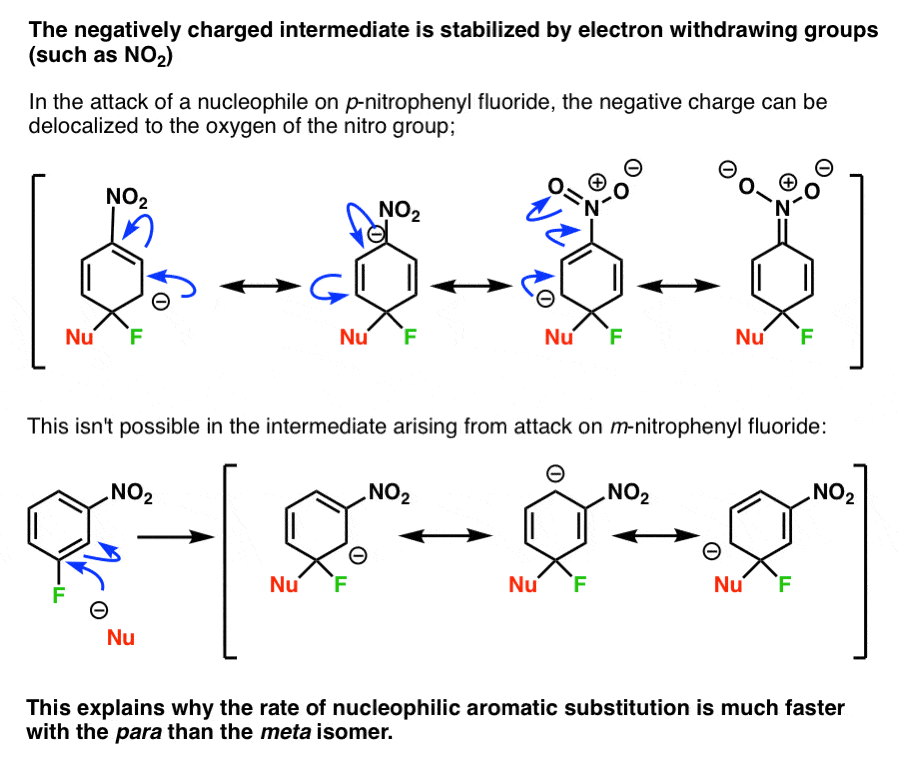
(This also explains why addition is fast for the ortho– isomer).
It also helps to explain why fluorine substituents increase the rate of nucleophilic aromatic substitution: the rate determining step is attack on the aromatic ring, not breaking the very strong C-F bond. The highly electronegative fluorine pulls electron density out of the ring, activating it towards attack.
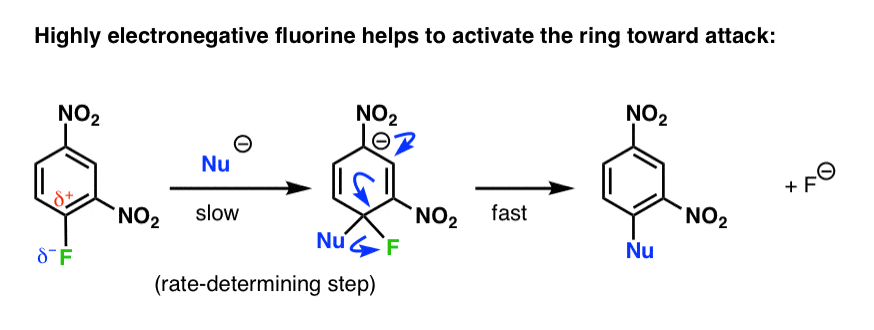
So even though breaking a C-F bond is generally not energetically favorable, this is compensated by the fact that it restores aromaticity.
[UPDATE: In the comments, Matt brings up a very interesting recent study that suggests that some nucleophilic aromatic substitution reactions that don’t have F as a leaving group may proceed through a concerted mechanism. I would agree in considering this more advanced material is unlikely to be covered in most introductory courses, (except maybe Eugene’s) but very worthy of interest.]
9. The Reaction Energy Diagram Of SNAr
Putting it all together, we can sketch out a reaction-energy diagram for this mechanism that would look something like this:
(remember: transitition states are “peaks”, and intermediates are “valleys”. Intermediates can (at least theoretically) be isolated; transition states have partial bonds, only last a femtosecond, and can’t be isolated).

The nucleophile adds to the aromatic ring through transition state A (the rate limiting step) to give the negatively charged intermediate B, with a further input of energy (Ea) ascends to transition state C (loss of the leaving group, the fast step) and from there, the final product.
10. A Few Examples
Here’s three representative examples:
- The first is a straightforward nucleophilic aromatic substitution using an amine as a nucleophile.
- The second uses a stronger base (NaOH) to make a weaker base (the conjugate base of phenol) which attacks the electron-poor ring. (A variation of this reaction was used in a synthesis of the antibiotic vancomycin)
- The third example shows the N-terminus of a peptide reacting with 2,4-dinitrophenyl fluoride in a nucleophilic aromatic substitution reaction. Fred Sanger used this reagent to label the terminal residues in insulin, which led (after a lot of detective work Note 2], to the first reported sequence of a protein (and a Nobel Prize in chemistry in 1958).
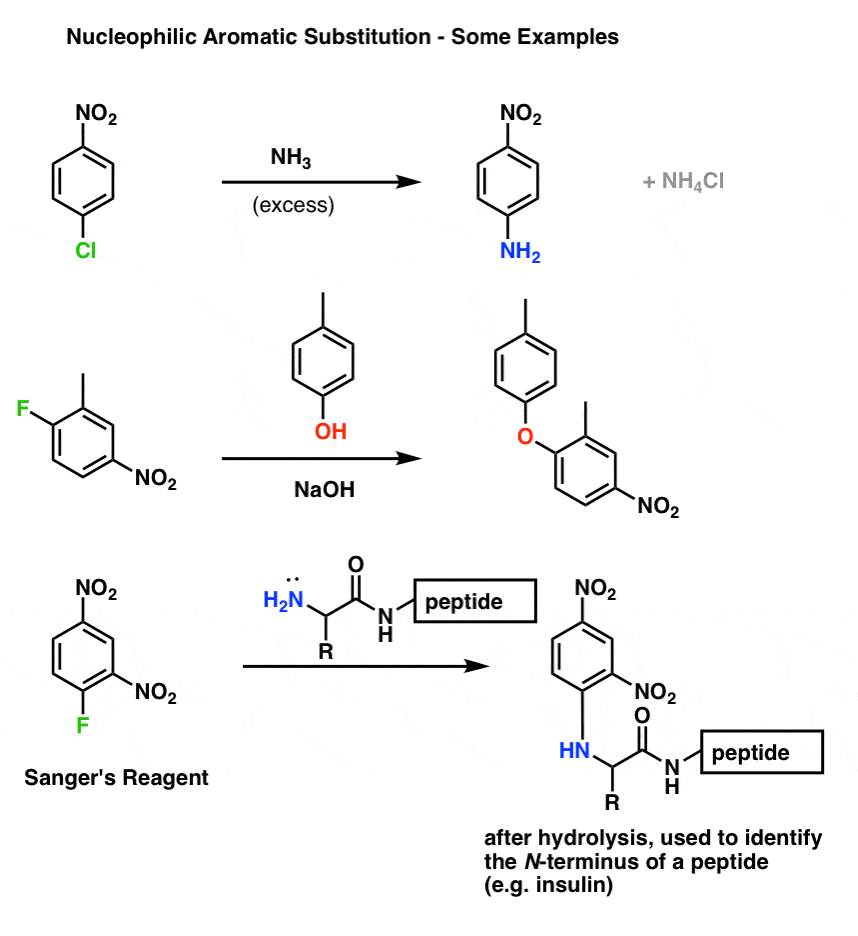
11. Summary: Nucleophilic Aromatic Substitution
Well, now you’ve seen something we once said was impossible: fluorine as a leaving group. While we’re here, what other commandments from Org 1 can we possibly break?
How about putting a triple bond on an aromatic ring?

That’s next!
In the next post, we’ll cover a reaction that also qualifies as “nucleophilic aromatic substitution” although it goes through a completely different mechanism, involving this “triple bond”, above.
Next Post: Nucleophilic Aromatic Substitution (2): Arynes
Notes
Related Articles
- Nucleophilic Aromatic Substitution (2) – The Benzyne Mechanism
- Reactions on the “Benzylic” Carbon: Bromination And Oxidation
- Nucleophilic Acyl Substitution (With Negatively Charged Nucleophiles)
- Nucleophilic Aromatic Substitution (SNAr) (MOC Membership)
- Ortho-, Para- and Meta- Directors in Electrophilic Aromatic Substitution
- Understanding Ortho, Para, and Meta Directors
- Electrophilic Aromatic Substitution Practice Problems (MOC Membership)
Note 1. This is for the reaction below:
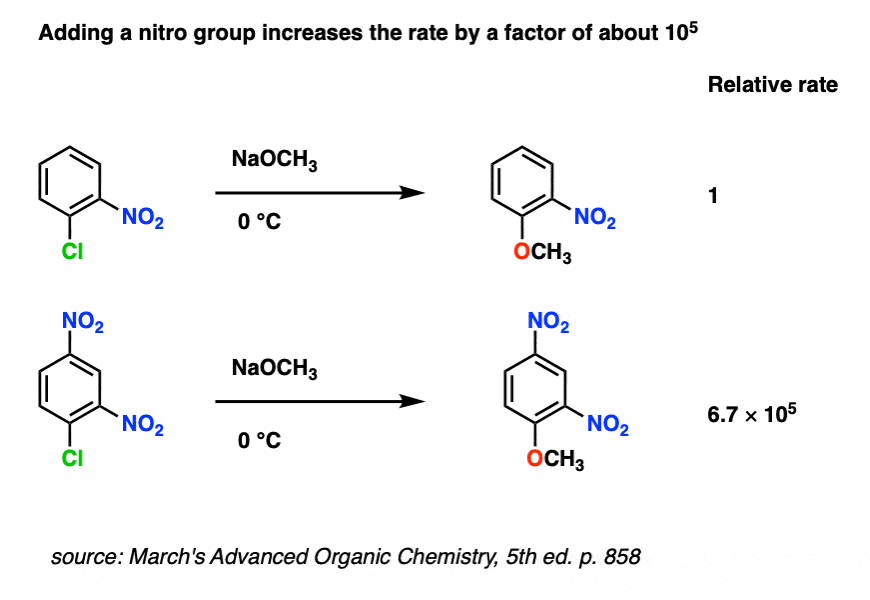
Note 2. Sanger’s detective work is detailed here.
Note 3. Link to the study is here.
Quiz Yourself!

Become a MOC member to see the clickable quiz with answers on the back.
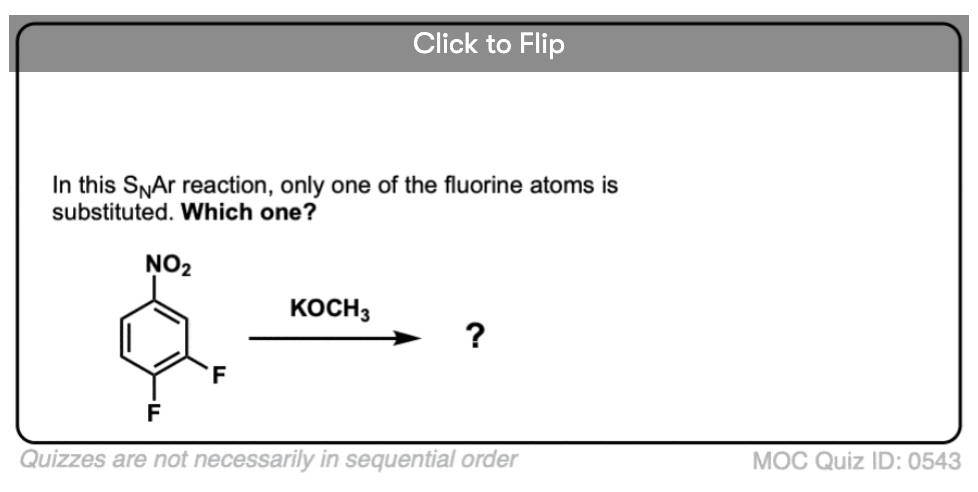
Become a MOC member to see the clickable quiz with answers on the back.

Become a MOC member to see the clickable quiz with answers on the back.
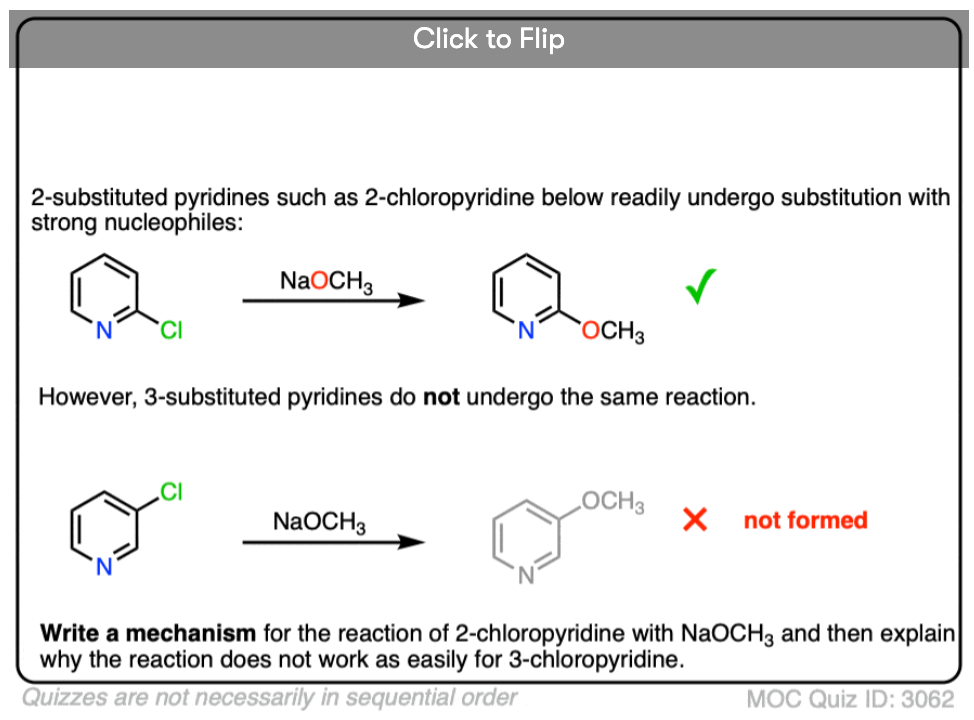
Become a MOC member to see the clickable quiz with answers on the back.
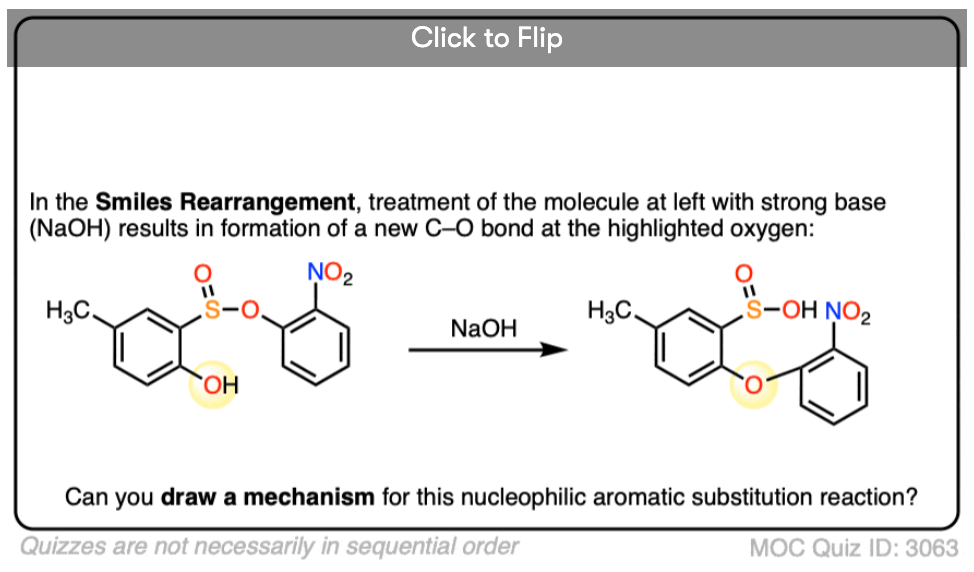
Become a MOC member to see the clickable quiz with answers on the back.
(Advanced) References and Further Reading
This is on nucleophilic aromatic substitution, specifically the addition-elimination reaction.
- Ueber Reactionen aromatischer Nitrokörper
Jakob Meisenheimer
Liebig. Ann. Chem. 1902, 323 (2), 205-246
DOI: 10.1002/jlac.19023230205
The addition intermediates from SNAr reactions can frequently be detected or isolated, and are called Meisenheimer complexes, after Jakob Meisenheimer, who first demonstrated their formation. - The SN mechanism in aromatic compounds. Part VII
Peter Briner, Joseph Miller, M. Liveris, and (Miss)P. G. Lutz
J. Chem. Soc., 1954, 1265-1266
DOI: 10.1039/JR9540001265 - The “Element Effect” as a Criterion of Mechanism in Activated Aromatic Nucleophilic Substitution Reactions
F. Bunnett, Edgar W. Garbisch Jr., and Kenneth M. Pruitt
Journal of the American Chemical Society 1957, 79 (2), 385-391
DOI: 10.1021/ja01559a040 - Nucleophilic substitution. Linear free energy relations between reactivity and physical properties of leaving groups and substrates
Giuseppe Bartoli and Paolo Edgardo Todesco
Accounts of Chemical Research 1977, 10 (4), 125-132
DOI: 10.1021/ar50112a004
These are mechanistic studies on the reaction, demonstrating that the order of reactivity is F > Cl > Br > I. In nucleophilic aromatic substitution, the formation of the addition intermediate is usually the rate-determining step so the ease of C-X bond breaking does not affect the rate. - NUCLEOPHILIC AROMATIC SUBSTITUTION OF ARYL FLUORIDES BY SECONDARY NITRILES: PREPARATION OF 2-(2-METHOXYPHENYL)-2-METHYLPROPIONITRILE
Stéphane Caron, Jill M. Wojcik, and Enrique Vazquez
Org. Synth. 2002, 79, 209
DOI: 10.15227/orgsyn.079.0209
A procedure in Organic Syntheses for an SNAr reaction, featuring nucleophilic displacement of an aryl fluoride. - The terminal peptides of insulin
Frederick Sanger
Biochemical Journal (1 January 1949) 45 (5): 563–574
DOI: 10.1042/bj0450563
One of this historically most significant examples of aromatic nucleophilic substitution is the reaction of amines with 2,4-dinitrofluorobenzene. This reaction was used by Frederick Sanger (who won 2 unshared Nobel Prizes in Chemistry) to develop a method for identification of the N-terminal amino acid in proteins. - Concerted nucleophilic aromatic substitutions
Eugene E. Kwan, Yuwen Zeng, Harrison A. Besser & Eric N. Jacobsen
Nature Chemistry volume 10, pages 917–923 (2018)
DOI: 10.1038/s41557-018-0079-7
This is at the cutting edge of chemistry – the authors use interesting NMR experiments to assert that SNAr reactions proceed through concerted rather than stepwise mechanism.
00 General Chemistry Review
01 Bonding, Structure, and Resonance
- How Do We Know Methane (CH4) Is Tetrahedral?
- Hybrid Orbitals and Hybridization
- How To Determine Hybridization: A Shortcut
- Orbital Hybridization And Bond Strengths
- Sigma bonds come in six varieties: Pi bonds come in one
- A Key Skill: How to Calculate Formal Charge
- The Four Intermolecular Forces and How They Affect Boiling Points
- 3 Trends That Affect Boiling Points
- How To Use Electronegativity To Determine Electron Density (and why NOT to trust formal charge)
- Introduction to Resonance
- How To Use Curved Arrows To Interchange Resonance Forms
- Evaluating Resonance Forms (1) - The Rule of Least Charges
- How To Find The Best Resonance Structure By Applying Electronegativity
- Evaluating Resonance Structures With Negative Charges
- Evaluating Resonance Structures With Positive Charge
- Exploring Resonance: Pi-Donation
- Exploring Resonance: Pi-acceptors
- In Summary: Evaluating Resonance Structures
- Drawing Resonance Structures: 3 Common Mistakes To Avoid
- How to apply electronegativity and resonance to understand reactivity
- Bond Hybridization Practice
- Structure and Bonding Practice Quizzes
- Resonance Structures Practice
02 Acid Base Reactions
- Introduction to Acid-Base Reactions
- Acid Base Reactions In Organic Chemistry
- The Stronger The Acid, The Weaker The Conjugate Base
- Walkthrough of Acid-Base Reactions (3) - Acidity Trends
- Five Key Factors That Influence Acidity
- Acid-Base Reactions: Introducing Ka and pKa
- How to Use a pKa Table
- The pKa Table Is Your Friend
- A Handy Rule of Thumb for Acid-Base Reactions
- Acid Base Reactions Are Fast
- pKa Values Span 60 Orders Of Magnitude
- How Protonation and Deprotonation Affect Reactivity
- Acid Base Practice Problems
03 Alkanes and Nomenclature
- Meet the (Most Important) Functional Groups
- Condensed Formulas: Deciphering What the Brackets Mean
- Hidden Hydrogens, Hidden Lone Pairs, Hidden Counterions
- Don't Be Futyl, Learn The Butyls
- Primary, Secondary, Tertiary, Quaternary In Organic Chemistry
- Branching, and Its Affect On Melting and Boiling Points
- The Many, Many Ways of Drawing Butane
- Wedge And Dash Convention For Tetrahedral Carbon
- Common Mistakes in Organic Chemistry: Pentavalent Carbon
- Table of Functional Group Priorities for Nomenclature
- Summary Sheet - Alkane Nomenclature
- Organic Chemistry IUPAC Nomenclature Demystified With A Simple Puzzle Piece Approach
- Boiling Point Quizzes
- Organic Chemistry Nomenclature Quizzes
04 Conformations and Cycloalkanes
- Staggered vs Eclipsed Conformations of Ethane
- Conformational Isomers of Propane
- Newman Projection of Butane (and Gauche Conformation)
- Introduction to Cycloalkanes
- Geometric Isomers In Small Rings: Cis And Trans Cycloalkanes
- Calculation of Ring Strain In Cycloalkanes
- Cycloalkanes - Ring Strain In Cyclopropane And Cyclobutane
- Cyclohexane Conformations
- Cyclohexane Chair Conformation: An Aerial Tour
- How To Draw The Cyclohexane Chair Conformation
- The Cyclohexane Chair Flip
- The Cyclohexane Chair Flip - Energy Diagram
- Substituted Cyclohexanes - Axial vs Equatorial
- Ranking The Bulkiness Of Substituents On Cyclohexanes: "A-Values"
- Cyclohexane Chair Conformation Stability: Which One Is Lower Energy?
- Fused Rings - Cis-Decalin and Trans-Decalin
- Naming Bicyclic Compounds - Fused, Bridged, and Spiro
- Bredt's Rule (And Summary of Cycloalkanes)
- Newman Projection Practice
- Cycloalkanes Practice Problems
05 A Primer On Organic Reactions
- The Most Important Question To Ask When Learning a New Reaction
- Curved Arrows (for reactions)
- Nucleophiles and Electrophiles
- The Three Classes of Nucleophiles
- Nucleophilicity vs. Basicity
- What Makes A Good Nucleophile?
- What Makes A Good Leaving Group?
- 3 Factors That Stabilize Carbocations
- Equilibrium and Energy Relationships
- 7 Factors that stabilize negative charge in organic chemistry
- 7 Factors That Stabilize Positive Charge in Organic Chemistry
- What's a Transition State?
- Hammond's Postulate
- Learning Organic Chemistry Reactions: A Checklist (PDF)
- Introduction to Oxidative Cleavage Reactions
06 Free Radical Reactions
- Bond Dissociation Energies = Homolytic Cleavage
- Free Radical Reactions
- 3 Factors That Stabilize Free Radicals
- What Factors Destabilize Free Radicals?
- Bond Strengths And Radical Stability
- Free Radical Initiation: Why Is "Light" Or "Heat" Required?
- Initiation, Propagation, Termination
- Monochlorination Products Of Propane, Pentane, And Other Alkanes
- Selectivity In Free Radical Reactions
- Selectivity in Free Radical Reactions: Bromination vs. Chlorination
- Halogenation At Tiffany's
- Allylic Bromination
- Bonus Topic: Allylic Rearrangements
- In Summary: Free Radicals
- Synthesis (2) - Reactions of Alkanes
- Free Radicals Practice Quizzes
07 Stereochemistry and Chirality
- Types of Isomers: Constitutional Isomers, Stereoisomers, Enantiomers, and Diastereomers
- How To Draw The Enantiomer Of A Chiral Molecule
- How To Draw A Bond Rotation
- Introduction to Assigning (R) and (S): The Cahn-Ingold-Prelog Rules
- Assigning Cahn-Ingold-Prelog (CIP) Priorities (2) - The Method of Dots
- Enantiomers vs Diastereomers vs The Same? Two Methods For Solving Problems
- Assigning R/S To Newman Projections (And Converting Newman To Line Diagrams)
- How To Determine R and S Configurations On A Fischer Projection
- The Meso Trap
- Optical Rotation, Optical Activity, and Specific Rotation
- Optical Purity and Enantiomeric Excess
- What's a Racemic Mixture?
- Chiral Allenes And Chiral Axes
- Stereochemistry Practice Problems and Quizzes
08 Substitution Reactions
- Nucleophilic Substitution Reactions - Introduction
- Two Types of Nucleophilic Substitution Reactions
- The SN2 Mechanism
- Why the SN2 Reaction Is Powerful
- The SN1 Mechanism
- The Conjugate Acid Is A Better Leaving Group
- Comparing the SN1 and SN2 Reactions
- Polar Protic? Polar Aprotic? Nonpolar? All About Solvents
- Steric Hindrance is Like a Fat Goalie
- Common Blind Spot: Intramolecular Reactions
- Substitution Practice - SN1
- Substitution Practice - SN2
09 Elimination Reactions
- Elimination Reactions (1): Introduction And The Key Pattern
- Elimination Reactions (2): The Zaitsev Rule
- Elimination Reactions Are Favored By Heat
- Two Elimination Reaction Patterns
- The E1 Reaction
- The E2 Mechanism
- E1 vs E2: Comparing the E1 and E2 Reactions
- Antiperiplanar Relationships: The E2 Reaction and Cyclohexane Rings
- Bulky Bases in Elimination Reactions
- Comparing the E1 vs SN1 Reactions
- Elimination (E1) Reactions With Rearrangements
- E1cB - Elimination (Unimolecular) Conjugate Base
- Elimination (E1) Practice Problems And Solutions
- Elimination (E2) Practice Problems and Solutions
10 Rearrangements
11 SN1/SN2/E1/E2 Decision
- Identifying Where Substitution and Elimination Reactions Happen
- Deciding SN1/SN2/E1/E2 (1) - The Substrate
- Deciding SN1/SN2/E1/E2 (2) - The Nucleophile/Base
- SN1 vs E1 and SN2 vs E2 : The Temperature
- Deciding SN1/SN2/E1/E2 - The Solvent
- Wrapup: The Key Factors For Determining SN1/SN2/E1/E2
- Alkyl Halide Reaction Map And Summary
- SN1 SN2 E1 E2 Practice Problems
12 Alkene Reactions
- E and Z Notation For Alkenes (+ Cis/Trans)
- Alkene Stability
- Alkene Addition Reactions: "Regioselectivity" and "Stereoselectivity" (Syn/Anti)
- Stereoselective and Stereospecific Reactions
- Hydrohalogenation of Alkenes and Markovnikov's Rule
- Hydration of Alkenes With Aqueous Acid
- Rearrangements in Alkene Addition Reactions
- Halogenation of Alkenes and Halohydrin Formation
- Oxymercuration Demercuration of Alkenes
- Hydroboration Oxidation of Alkenes
- m-CPBA (meta-chloroperoxybenzoic acid)
- OsO4 (Osmium Tetroxide) for Dihydroxylation of Alkenes
- Palladium on Carbon (Pd/C) for Catalytic Hydrogenation of Alkenes
- Cyclopropanation of Alkenes
- A Fourth Alkene Addition Pattern - Free Radical Addition
- Alkene Reactions: Ozonolysis
- Summary: Three Key Families Of Alkene Reaction Mechanisms
- Synthesis (4) - Alkene Reaction Map, Including Alkyl Halide Reactions
- Alkene Reactions Practice Problems
13 Alkyne Reactions
- Acetylides from Alkynes, And Substitution Reactions of Acetylides
- Partial Reduction of Alkynes With Lindlar's Catalyst
- Partial Reduction of Alkynes With Na/NH3 To Obtain Trans Alkenes
- Alkyne Hydroboration With "R2BH"
- Hydration and Oxymercuration of Alkynes
- Hydrohalogenation of Alkynes
- Alkyne Halogenation: Bromination and Chlorination of Alkynes
- Alkyne Reactions - The "Concerted" Pathway
- Alkenes To Alkynes Via Halogenation And Elimination Reactions
- Alkynes Are A Blank Canvas
- Synthesis (5) - Reactions of Alkynes
- Alkyne Reactions Practice Problems With Answers
14 Alcohols, Epoxides and Ethers
- Alcohols - Nomenclature and Properties
- Alcohols Can Act As Acids Or Bases (And Why It Matters)
- Alcohols - Acidity and Basicity
- The Williamson Ether Synthesis
- Ethers From Alkenes, Tertiary Alkyl Halides and Alkoxymercuration
- Alcohols To Ethers via Acid Catalysis
- Cleavage Of Ethers With Acid
- Epoxides - The Outlier Of The Ether Family
- Opening of Epoxides With Acid
- Epoxide Ring Opening With Base
- Making Alkyl Halides From Alcohols
- Tosylates And Mesylates
- PBr3 and SOCl2
- Elimination Reactions of Alcohols
- Elimination of Alcohols To Alkenes With POCl3
- Alcohol Oxidation: "Strong" and "Weak" Oxidants
- Demystifying The Mechanisms of Alcohol Oxidations
- Protecting Groups For Alcohols
- Thiols And Thioethers
- Calculating the oxidation state of a carbon
- Oxidation and Reduction in Organic Chemistry
- Oxidation Ladders
- SOCl2 Mechanism For Alcohols To Alkyl Halides: SN2 versus SNi
- Alcohol Reactions Roadmap (PDF)
- Alcohol Reaction Practice Problems
- Epoxide Reaction Quizzes
- Oxidation and Reduction Practice Quizzes
15 Organometallics
- What's An Organometallic?
- Formation of Grignard and Organolithium Reagents
- Organometallics Are Strong Bases
- Reactions of Grignard Reagents
- Protecting Groups In Grignard Reactions
- Synthesis Problems Involving Grignard Reagents
- Grignard Reactions And Synthesis (2)
- Organocuprates (Gilman Reagents): How They're Made
- Gilman Reagents (Organocuprates): What They're Used For
- The Heck, Suzuki, and Olefin Metathesis Reactions (And Why They Don't Belong In Most Introductory Organic Chemistry Courses)
- Reaction Map: Reactions of Organometallics
- Grignard Practice Problems
16 Spectroscopy
- Degrees of Unsaturation (or IHD, Index of Hydrogen Deficiency)
- Conjugation And Color (+ How Bleach Works)
- Introduction To UV-Vis Spectroscopy
- UV-Vis Spectroscopy: Absorbance of Carbonyls
- UV-Vis Spectroscopy: Practice Questions
- Bond Vibrations, Infrared Spectroscopy, and the "Ball and Spring" Model
- Infrared Spectroscopy: A Quick Primer On Interpreting Spectra
- IR Spectroscopy: 4 Practice Problems
- 1H NMR: How Many Signals?
- Homotopic, Enantiotopic, Diastereotopic
- Diastereotopic Protons in 1H NMR Spectroscopy: Examples
- 13-C NMR - How Many Signals
- Liquid Gold: Pheromones In Doe Urine
- Natural Product Isolation (1) - Extraction
- Natural Product Isolation (2) - Purification Techniques, An Overview
- Structure Determination Case Study: Deer Tarsal Gland Pheromone
17 Dienes and MO Theory
- What To Expect In Organic Chemistry 2
- Are these molecules conjugated?
- Conjugation And Resonance In Organic Chemistry
- Bonding And Antibonding Pi Orbitals
- Molecular Orbitals of The Allyl Cation, Allyl Radical, and Allyl Anion
- Pi Molecular Orbitals of Butadiene
- Reactions of Dienes: 1,2 and 1,4 Addition
- Thermodynamic and Kinetic Products
- More On 1,2 and 1,4 Additions To Dienes
- s-cis and s-trans
- The Diels-Alder Reaction
- Cyclic Dienes and Dienophiles in the Diels-Alder Reaction
- Stereochemistry of the Diels-Alder Reaction
- Exo vs Endo Products In The Diels Alder: How To Tell Them Apart
- HOMO and LUMO In the Diels Alder Reaction
- Why Are Endo vs Exo Products Favored in the Diels-Alder Reaction?
- Diels-Alder Reaction: Kinetic and Thermodynamic Control
- The Retro Diels-Alder Reaction
- The Intramolecular Diels Alder Reaction
- Regiochemistry In The Diels-Alder Reaction
- The Cope and Claisen Rearrangements
- Electrocyclic Reactions
- Electrocyclic Ring Opening And Closure (2) - Six (or Eight) Pi Electrons
- Diels Alder Practice Problems
- Molecular Orbital Theory Practice
18 Aromaticity
- Introduction To Aromaticity
- Rules For Aromaticity
- Huckel's Rule: What Does 4n+2 Mean?
- Aromatic, Non-Aromatic, or Antiaromatic? Some Practice Problems
- Antiaromatic Compounds and Antiaromaticity
- The Pi Molecular Orbitals of Benzene
- The Pi Molecular Orbitals of Cyclobutadiene
- Frost Circles
- Aromaticity Practice Quizzes
19 Reactions of Aromatic Molecules
- Electrophilic Aromatic Substitution: Introduction
- Activating and Deactivating Groups In Electrophilic Aromatic Substitution
- Electrophilic Aromatic Substitution - The Mechanism
- Ortho-, Para- and Meta- Directors in Electrophilic Aromatic Substitution
- Understanding Ortho, Para, and Meta Directors
- Why are halogens ortho- para- directors?
- Disubstituted Benzenes: The Strongest Electron-Donor "Wins"
- Electrophilic Aromatic Substitutions (1) - Halogenation of Benzene
- Electrophilic Aromatic Substitutions (2) - Nitration and Sulfonation
- EAS Reactions (3) - Friedel-Crafts Acylation and Friedel-Crafts Alkylation
- Intramolecular Friedel-Crafts Reactions
- Nucleophilic Aromatic Substitution (NAS)
- Nucleophilic Aromatic Substitution (2) - The Benzyne Mechanism
- Reactions on the "Benzylic" Carbon: Bromination And Oxidation
- The Wolff-Kishner, Clemmensen, And Other Carbonyl Reductions
- More Reactions on the Aromatic Sidechain: Reduction of Nitro Groups and the Baeyer Villiger
- Aromatic Synthesis (1) - "Order Of Operations"
- Synthesis of Benzene Derivatives (2) - Polarity Reversal
- Aromatic Synthesis (3) - Sulfonyl Blocking Groups
- Birch Reduction
- Synthesis (7): Reaction Map of Benzene and Related Aromatic Compounds
- Aromatic Reactions and Synthesis Practice
- Electrophilic Aromatic Substitution Practice Problems
20 Aldehydes and Ketones
- What's The Alpha Carbon In Carbonyl Compounds?
- Nucleophilic Addition To Carbonyls
- Aldehydes and Ketones: 14 Reactions With The Same Mechanism
- Sodium Borohydride (NaBH4) Reduction of Aldehydes and Ketones
- Grignard Reagents For Addition To Aldehydes and Ketones
- Wittig Reaction
- Hydrates, Hemiacetals, and Acetals
- Imines - Properties, Formation, Reactions, and Mechanisms
- All About Enamines
- Breaking Down Carbonyl Reaction Mechanisms: Reactions of Anionic Nucleophiles (Part 2)
- Aldehydes Ketones Reaction Practice
21 Carboxylic Acid Derivatives
- Nucleophilic Acyl Substitution (With Negatively Charged Nucleophiles)
- Addition-Elimination Mechanisms With Neutral Nucleophiles (Including Acid Catalysis)
- Basic Hydrolysis of Esters - Saponification
- Transesterification
- Proton Transfer
- Fischer Esterification - Carboxylic Acid to Ester Under Acidic Conditions
- Lithium Aluminum Hydride (LiAlH4) For Reduction of Carboxylic Acid Derivatives
- LiAlH[Ot-Bu]3 For The Reduction of Acid Halides To Aldehydes
- Di-isobutyl Aluminum Hydride (DIBAL) For The Partial Reduction of Esters and Nitriles
- Amide Hydrolysis
- Thionyl Chloride (SOCl2) And Conversion of Carboxylic Acids to Acid Halides
- Diazomethane (CH2N2)
- Carbonyl Chemistry: Learn Six Mechanisms For the Price Of One
- Making Music With Mechanisms (PADPED)
- Carboxylic Acid Derivatives Practice Questions
22 Enols and Enolates
- Keto-Enol Tautomerism
- Enolates - Formation, Stability, and Simple Reactions
- Kinetic Versus Thermodynamic Enolates
- Aldol Addition and Condensation Reactions
- Reactions of Enols - Acid-Catalyzed Aldol, Halogenation, and Mannich Reactions
- Claisen Condensation and Dieckmann Condensation
- Decarboxylation
- The Malonic Ester and Acetoacetic Ester Synthesis
- The Michael Addition Reaction and Conjugate Addition
- The Robinson Annulation
- Haloform Reaction
- The Hell–Volhard–Zelinsky Reaction
- Enols and Enolates Practice Quizzes
23 Amines
- The Amide Functional Group: Properties, Synthesis, and Nomenclature
- Basicity of Amines And pKaH
- 5 Key Basicity Trends of Amines
- The Mesomeric Effect And Aromatic Amines
- Nucleophilicity of Amines
- Alkylation of Amines (Sucks!)
- Reductive Amination
- The Gabriel Synthesis
- Some Reactions of Azides
- The Hofmann Elimination
- The Hofmann and Curtius Rearrangements
- The Cope Elimination
- Protecting Groups for Amines - Carbamates
- The Strecker Synthesis of Amino Acids
- Introduction to Peptide Synthesis
- Reactions of Diazonium Salts: Sandmeyer and Related Reactions
- Amine Practice Questions
24 Carbohydrates
- D and L Notation For Sugars
- Pyranoses and Furanoses: Ring-Chain Tautomerism In Sugars
- What is Mutarotation?
- Reducing Sugars
- The Big Damn Post Of Carbohydrate-Related Chemistry Definitions
- The Haworth Projection
- Converting a Fischer Projection To A Haworth (And Vice Versa)
- Reactions of Sugars: Glycosylation and Protection
- The Ruff Degradation and Kiliani-Fischer Synthesis
- Isoelectric Points of Amino Acids (and How To Calculate Them)
- Carbohydrates Practice
- Amino Acid Quizzes
25 Fun and Miscellaneous
- A Gallery of Some Interesting Molecules From Nature
- Screw Organic Chemistry, I'm Just Going To Write About Cats
- On Cats, Part 1: Conformations and Configurations
- On Cats, Part 2: Cat Line Diagrams
- On Cats, Part 4: Enantiocats
- On Cats, Part 6: Stereocenters
- Organic Chemistry Is Shit
- The Organic Chemistry Behind "The Pill"
- Maybe they should call them, "Formal Wins" ?
- Why Do Organic Chemists Use Kilocalories?
- The Principle of Least Effort
- Organic Chemistry GIFS - Resonance Forms
- Reproducibility In Organic Chemistry
- What Holds The Nucleus Together?
- How Reactions Are Like Music
- Organic Chemistry and the New MCAT
26 Organic Chemistry Tips and Tricks
- Common Mistakes: Formal Charges Can Mislead
- Partial Charges Give Clues About Electron Flow
- Draw The Ugly Version First
- Organic Chemistry Study Tips: Learn the Trends
- The 8 Types of Arrows In Organic Chemistry, Explained
- Top 10 Skills To Master Before An Organic Chemistry 2 Final
- Common Mistakes with Carbonyls: Carboxylic Acids... Are Acids!
- Planning Organic Synthesis With "Reaction Maps"
- Alkene Addition Pattern #1: The "Carbocation Pathway"
- Alkene Addition Pattern #2: The "Three-Membered Ring" Pathway
- Alkene Addition Pattern #3: The "Concerted" Pathway
- Number Your Carbons!
- The 4 Major Classes of Reactions in Org 1
- How (and why) electrons flow
- Grossman's Rule
- Three Exam Tips
- A 3-Step Method For Thinking Through Synthesis Problems
- Putting It Together
- Putting Diels-Alder Products in Perspective
- The Ups and Downs of Cyclohexanes
- The Most Annoying Exceptions in Org 1 (Part 1)
- The Most Annoying Exceptions in Org 1 (Part 2)
- The Marriage May Be Bad, But the Divorce Still Costs Money
- 9 Nomenclature Conventions To Know
- Nucleophile attacks Electrophile
27 Case Studies of Successful O-Chem Students
- Success Stories: How Corina Got The The "Hard" Professor - And Got An A+ Anyway
- How Helena Aced Organic Chemistry
- From a "Drop" To B+ in Org 2 – How A Hard Working Student Turned It Around
- How Serge Aced Organic Chemistry
- Success Stories: How Zach Aced Organic Chemistry 1
- Success Stories: How Kari Went From C– to B+
- How Esther Bounced Back From a "C" To Get A's In Organic Chemistry 1 And 2
- How Tyrell Got The Highest Grade In Her Organic Chemistry Course
- This Is Why Students Use Flashcards
- Success Stories: How Stu Aced Organic Chemistry
- How John Pulled Up His Organic Chemistry Exam Grades
- Success Stories: How Nathan Aced Organic Chemistry (Without It Taking Over His Life)
- How Chris Aced Org 1 and Org 2
- Interview: How Jay Got an A+ In Organic Chemistry
- How to Do Well in Organic Chemistry: One Student's Advice
- "America's Top TA" Shares His Secrets For Teaching O-Chem
- "Organic Chemistry Is Like..." - A Few Metaphors
- How To Do Well In Organic Chemistry: Advice From A Tutor
- Guest post: "I went from being afraid of tests to actually looking forward to them".
How to get Master organic chemistry in a single pdf
what is the reasoning behind finding the leaving group capacity for diff lgs for this reaction
Well, the rate-determining-step is attack of the nucleophile to the aromatic ring, which disrupts aromaticity, as opposed to loss of the leaving group.
The rationale as to why F accelerates the reaction relative to Cl and Br is that F is highly electronegative, which creates a large partial positive charge on the carbon it’s bonded to, making it more electrophilic (and increasing the rate of this first step).
IN the quiz question how do we decide which fluorine atom is going to get replaced by nucleophile??
Start by drawing the product of addition to the aromatic ring at each of the positions where there is a fluorine. Which anion will be more stable?
what will be the product in the following case?
2-bromo-4,6-dinitrophenol + methoxide ion –>?
You will put a CH3O in place of Br
can you explain quiz id 0543 for me ,please ?
only halogens act as leaving group or any other group can also act as LG ?
The best leaving group is F, but other groups can be leaving groups as well like Cl, Br, and OTs.
European Journal of Medicinal Chemistry, 2020, vol. 192
General procedure: To the solution of aromatic amine (0.7mmol) and the corresponding chlorinated 1,6-naphthyridine (0.7mmol) in isopropanol (10mL), HCl (20mmol%) was added drop-wise, and then heated to 90°C under nitrogen for 2h. The mixture was filtered, and the solid was dissolved in ethyl acetate. The solution was stired with K2CO3 (1mmol) at r.t. for 1h and filtered. The filtrate was concentrated in vacuum and purified by flash chromatography (CH2Cl2/MeOH=20:1) to yield the corresponding targets.
I want to ask: for some Heteroaromatic chloride, why can some acids (such as HCl, several drops) can promote SNAr reaction at high temperature. Thanks
What’s the specific reaction? What’s performing the substitution?
Can I ask for 3,4-dibromonitrobenzene reacting with excess pyrrolidine, only the Br para to NO2 will be substituted right?
Think about the negative charge that is formed through addition of pyrrolidine to the ring, and the resulting resonance forms. Attack at one position will be greatly favored over another. You have likely thought this through, judging from your answer, so I need not comment further.
So, you mean the negative charge will be more stable when it attacks at F than that at NO2? ?
Why the nucleophile does not attack on carbon at which NO2 is connected?
As a good nucleophile is not necessary and there will be more partial positive charge on NO2 ‘s carbon than that of F which attracts the nucleophile better?
If it attacks at that carbon then where does the negative charge go? :-?
Thankyou was very helpful
Great, thanks Pracheta.
You probably already read this, and I think it’s inappropriate to ever teach in Sophomore organic, because it contains too many exceptions on top of exceptions, but….
Recent research suggests many substrates react via a concerted mechanism. The computational evidence had suggested it for a while, and experimental research recently caught up. A better leaving group like bromine, and a weaker electron withdrawing group, tends to favor a concerted mechanism. The “original” reaction with a fluoride leaving group, and multiple nitro groups, is still step-wise.
I would like to read the original paper, but there’s a nice synopsis here:
https://chemistrycommunity.nature.com/users/108263-eugene-kwan/posts/36587-one-step-at-time-most-nucleophilic-aromatic-substitutions-are-concerted
It’s the same debate we can have over the mechanism of an alkyne hydrohalogenation–is it stepwise or concerted termolecular? I believe it is important to note to the students that there are some variations of the mechanism that go beyond the scope of the course, here we’ll only look at one “classic” mechanism. Otherwise students can get very confused and frustrated when they come across a different version or a deeper more involved discussion of the mechanism and feel like all they were taught is “incorrect” or start questioning what exactly they were taught and how much of it is “incorrect.”